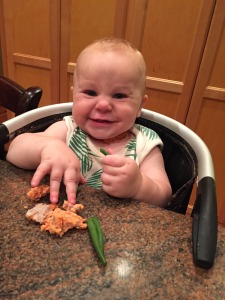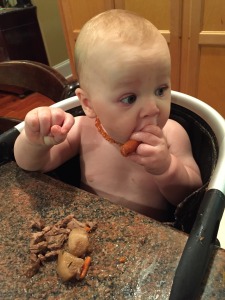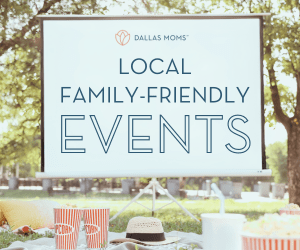I have to admit that I was one of those moms that registered for every baby food gadget in existence. I had this idea that I would make my own foods, puree up the world, and feed my first son homemade smoothies with a spoon. But in a short time, I discovered out this idea was an overwhelming time commitment.
 Through a friend I discovered “baby-led weaning” (BLW), a practice of babies simply feeding themselves solid foods. My first son took to it quickly, eating what my husband and I ate. This saved me time and also developed him an incredibly mature palette: he loves spicy food, meats, vegetables, and everything else in the world (except avocados and hummus, ha!). We are 3 months into BLW with our second son and things are going equally as well. So far he LOVES Pot Roast, just like his Mama.
Through a friend I discovered “baby-led weaning” (BLW), a practice of babies simply feeding themselves solid foods. My first son took to it quickly, eating what my husband and I ate. This saved me time and also developed him an incredibly mature palette: he loves spicy food, meats, vegetables, and everything else in the world (except avocados and hummus, ha!). We are 3 months into BLW with our second son and things are going equally as well. So far he LOVES Pot Roast, just like his Mama.
What is Baby-Led Weaning and Why should I try it?
Baby led weaning is simply babies feeding themselves. It is not about weaning off the breast or formula, but weaning onto solid foods, where the former occurs naturally. Babies practice to pick up food and chew, before they eventually learn to swallow. With purees the reverse occurs, and babies are highly dependent on being fed vs. learning to feed themselves.
But won’t my baby choke?
Children that are ready for BLW are capable of working it out on their own. Gagging is a normal reflex and part of the learning process. Choking is something completely different, where the baby will look panicked and there will be very little noise. My best advice is to be present at all times while your baby is eating. Also it’s always good to be up to date on your infant CPR and Heimlich classes whether you are BLW or not.
BLW babies are encouraged to join the family at meal time, choose how much and how fast to eat, given the freedom to explore taste and textures and continue to nurse or bottle feed — solids become a compliment to milk.
BLW has a few key benefits that I’ve observed:
 • It’s EASIER! Pureeing is time consuming and when babies are able to feed themselves, you can enjoy your meal as well. No more juggling 10 things at once. Sit down and enjoy a meal together as a family.
• It’s EASIER! Pureeing is time consuming and when babies are able to feed themselves, you can enjoy your meal as well. No more juggling 10 things at once. Sit down and enjoy a meal together as a family.
• Baby develops good eating habits. BLW babies are exposed to many healthy foods early on so they are more likely to continue to enjoy those foods later in life. It expands their pallet and makes them more adventurous about trying new things.
• It’s educational. Babies learn how to handle different textures, sizes and consistencies of food. They work on hand eye coordination, fine motor skills and they get to sit at the table and watch others talk and eat
When is my baby ready?
Babies are ready to begin BLW around 6 months of age when they begin to reach for food. This is a sign that they are developmentally ready to feed themselves.
Each child is different, but here are some signs that they are ready:
– They are able to sit up on their own.
– They have developed fine motor skills to self-feed.
– They have stopped automatically pushing solids out of their mouth.
– They are willing to chew even with no teeth.
– They show interest in participating at mealtime and try to grab food off your plate.
Where do I start?
All you’ll need is a knife, some healthy finger food options and a highchair or parents lap. It’s that easy!
I personally started with veggies, then fruit, and then gradually introduced gluten-free grains, and lastly fats. In my household we do not eat dairy and we eat very little grains and if we do they are always gluten-free. So this part can be tweaked for your families eating habits.
Once you have your finger food prepared in chunks large enough for the baby to pick up, follow your babies lead. Offer them a few options and let them decide what and how much they want. Start with once a day and then gradually increase. I always had water available as well. Also, do not feel the need to feed them if you are worried they aren’t eating enough. They are getting enough calories from milk — this is just about learning at this point.
You will soon notice a change in their diapers which will show you that they really are eating. Also, my child thought hummus was paint and quinoa was to be thrown all over the kitchen so I do recommend a large splat mat under the highchair or a puppy dog cleaning crew like I have. Embrace the mess because you will thank me later!
Food ideas
– Avocados
– Bananas
– Sweet Potatoes
– Squashes
– Apples
– Soft carrots, peas, green beans zucchini and beets
– Peaches, plums, pears, melon and berries
– Meat, poultry and fish
– Slices of bread, cooked pasta, brown rice, quinoa and oatmeal
– Hummus
– Beans
 Foods to be avoided
Foods to be avoided
– Obvious choking hazards
– Foods high in allergens – eggs, nuts, chocolate, shellfish and honey
– Salt and sugar
– Processed food
Tips for BLW
- Make sure to cut your pieces large enough that a baby can grasp them easily – small pieces won’t work
- Understand that it will be a slow process but they will get the hang of it
- Don’t put them in the highchair hungry because the food will just be thrown — make sure they are breast or bottle fed an hour prior.
- Forget bowls — they just get thrown. Put the food right onto the highchair tray.
- Spoons are still fun for babies and they like to try and feed themselves. Always offer a spoon when appropriate.
- Don’t forget a splat mat! Also offer small amounts of food at a time so the baby doesn’t get overwhelmed and throw the food everywhere.
- On the go — pack easy finger foods like bananas, apple slices or pasta
- Feel free to use spices! Mint, cinnamon and sage are some of my favorites.
For more information on BLW
Baby Led Weaning – Essential Guide to Introducing Solid Foods by Gill Rapley and Tracey Murkett
The Baby Led Weaning Coobook by Gill Rapley and Tracey Murkett













